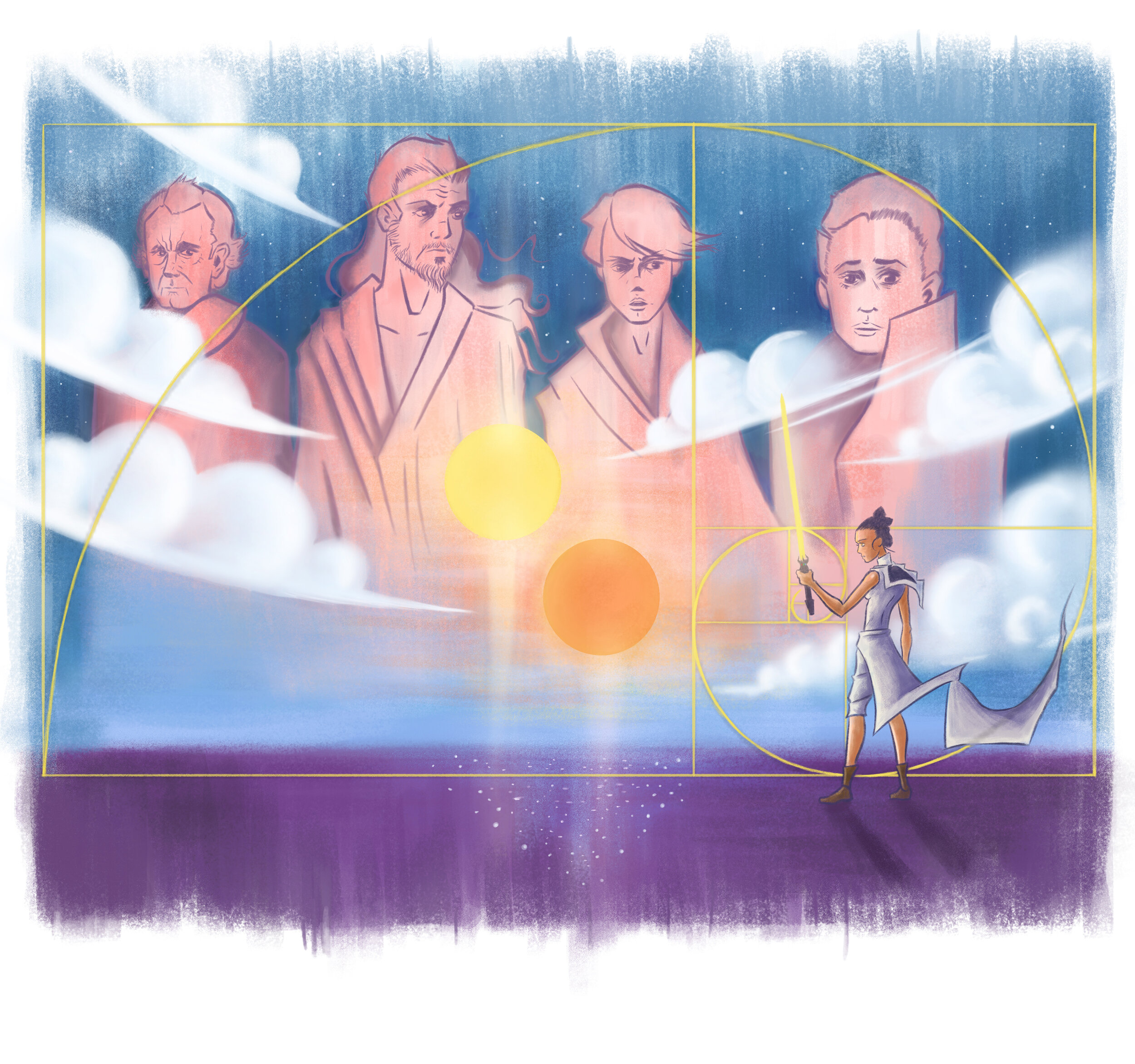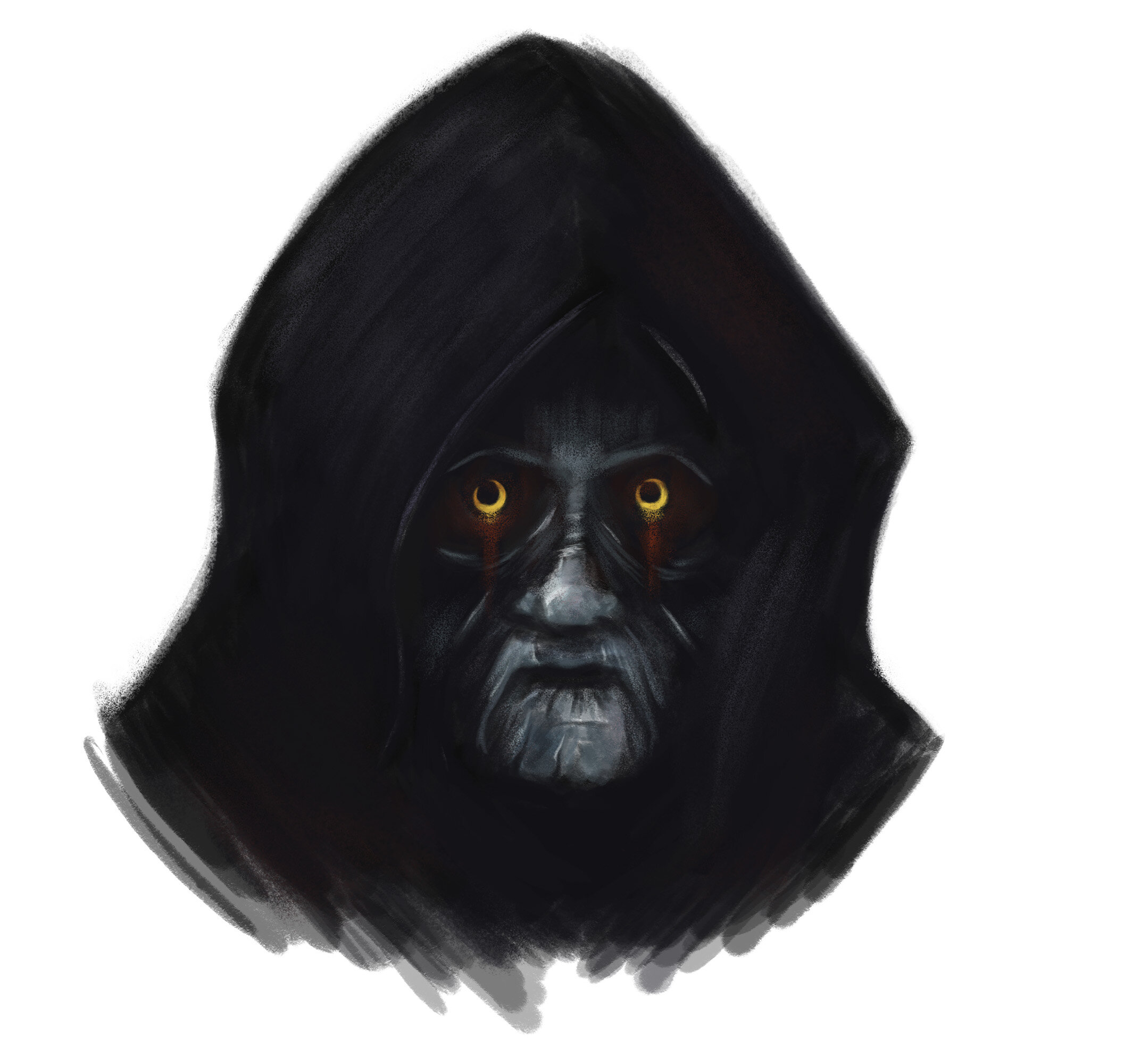The Golden Rey

I should be upfront about this: I love Star Wars unapologetically. Always have, always will.
I was born the year Return of the Jedi came out. I grew up with Ewoks printed on my bed sheets. The first time I saw Luke, over the sarlacc pit, force-flip to catch a droid-jettisoned lightsaber, and draw its new green beam badass future sword - my brain exploded.
It’s still exploding.
In many ways, Star Wars is one of the primary reasons I got into storytelling / comic book drawing in the first place. It’s one of my oldest and strongest fandoms. That being said, I will never use the word “rising” in any title I ever write. It’s how two huge franchises decided to title their closing chapters. Hey kids, do you like Batman? Do you like the Dark Knight? Well how about The Dark Knight R I S E S ? Hey kids, you like Star Wars - you little shits, you like lightsabers? How about some R I S E of Skywalker?
I’ll also freely admit that Star Wars is a disjointed mess of a franchise. It went from a low budget 70’s sci-fi fantasy high concept film to international success, the first “blockbuster” film, to a huge media Empire in its own right. But there was never really a plan. George Lucas had outlines of the films; probably more like jotted down notes, but I do think there was some sort of larger concept in his head, it just never came to fruition in a cohesive way. For instance, the midi-chlorians idea only really shows up in Episode I as a point of discussion. It’s briefly mentioned in Episode III, in the cardinal Opera scene and then nowhere else. The concept may be the impetus of getting the story going but then is explored no further.
Now, Star Wars is owned by Disney and revered about as much as an old reliable alien cow whose blue milk has gone sour. The Prequel Trilogy is widely despised by many of the fans and the Sequel Trilogy did little to win them back. Despite this though, a case could be made that Star Wars has never been bigger and more lucrative.
The Sequel Trilogy grossed over $4.5 Billion, with each installment passing the $1B mark at the Box Office. And that of course is only the films. Star Wars always was and continues to be a merchandise and toy brand, generating billions of dollars independently of the films.
Even though George Lucas sold LucasFilm to Disney, he did have a third trilogy in mind:
“So, I took the screenplay and divided it into three stories, and rewrote the first one. ... Then, I had the other two films, which were essentially split into three parts each, two trilogies. When the smoke cleared, I said, 'This is really great. I'll do another trilogy that takes place after this.' I had three trilogies of nine films, and then another couple of odd films. ... It's a nine-part saga that has a beginning, a middle and an end. It progresses over a period of about fifty or sixty years with about twenty years between trilogies, each trilogy taking about six or seven years.”
- George Lucas
The lightsaber colors canonically have their own meaning, but since much of Star Wars is open to interpretation, I’m going to explain what they mean to me. The Green Lightsabers are for Masters (Qui-Gon and Yoda); The Blue Lightsabers are for the more common Jedi Knights (Obi-Wan and Anakin, then Luke, Rey, Ben). The Rare Purple Lightsaber (Mace Windu because Samuel L Jackson) but also because Mace had trained in ways of using the dark side of the force without succumbing to it.
Then there are the Red Lightsabers wielded by acolytes of the Dark Side. Kylo, Vader, Dooku, Maul...
Palpatine.
But then there are the Yellow Lightsabers, which only make one appearance in the entire Saga - at the very end - the very last shot. They appear elsewhere in comic books and video games, but, let me just get this out of the way: I’m a Film Canonical Star Wars nerd - it either happened in the films or not at all. The only exceptions to this are The Mandolorian and, of course, the cinematic masterpiece that is Dark Forces II: Jedi Knight.
Thematically, Rey and the Golden Saber represent a purification.
A redemption, the key that ties everything together.
“Darkness rises and Light to meet it. I warned my young apprentice that as he grew stronger, his equal in the light would rise. ”
-Snoke
Star Wars tells the story of a Jedi Master: Qui-Gon Jinn, and his young apprentice Obi-Wan Kenobi, being sent on a routine mission to settle a trade dispute on Naboo. Qui-Gon, unusually attuned to what he calls “the living force,” senses a lot of fear for something that should otherwise be trivial. He senses a darkness manipulating and stirring behind the scenes. The Jedi are immediately met with violence and they just barely escape Naboo with the Queen and a few allies intact. They end up stranded on Tatooine and the only person willing to help them is a little boy. This boy is unusually adept with the force…
To Qui-Gon, this boy represents the fulfillment of an ancient Jedi prophecy - that one would come to balance the force. When I was younger, I always thought it made sense that Anakin became Darth Vader and destroyed the Jedi - thus balancing the force. There are only two Sith after all and hundreds if not thousands of Jedi; if anything the force needs to be balanced by decreasing the light and increasing the dark. But, after watching the Saga as a whole, in its entirety, I no longer think this is the case.
The force is out of balance because something has been bending it towards the dark side. Like a black hole, it can’t be seen directly, but the effect of its gravity can be observed in other ways; and likewise it is ancient, primal, and enormously powerful. There’s a scene in Episode III where Anakin tells Mace, for instance, that he thinks Palpatine is a secret Sith, “the one we’ve been looking for.”
This is the Phantom Menace. Qui-Gon unfortunately was the only Jedi Master that really got a sense of it. The prophecy is that one will bring harmony to the Force - to balance it - by mitigating this looming darkness; to end the Sith. To find the one that would bring balance accidentally, on a wayward desert planet, seems like providence to the old Jedi.
Qui-Gon brings young Anakin before the council and refers to him as “a vergence in the force.” This vergence is between the Dark and the Light themselves - combining to create new life. Of course, the tragedy of the Prequel Trilogy is that Anakin ultimately falls to the Dark Side and doesn’t balance anything. He doesn’t destroy the Sith. He becomes one and destroys the Jedi.
The entire mythos of Star Wars is about the Dark rising and the Light to meet it. In Episode III, the Darkness wins. In Episode IV, the New Hope is Luke. He comes along and redeems his father. Anakin, in the end, rejects the Dark Side and rejects Palpatine but only after the sacrifice and suffering of Luke. It’s hard to ignore the Christian overtones here.
For a time, there was balance. Luke set up a new temple and started training a new generation of Jedi. But the darkness was not gone. It found Ben Solo, Luke’s own nephew, and festered in his heart, eventually consuming him, and creating Kylo Ren - perhaps even more powerful than Vader himself. The darkness could not be destroyed, Luke thought. It will always return. So he abandoned the Force and went into exile.
Rey doesn’t know her place. A lonely girl on a forgotten world, waiting for her parents who long ago abandoned her, Rey searches for any semblance of home. Much like the original Saga, she is thrust into adventure by the arrival of a droid on a secret mission. Along the way, she discovers that she has a dormant power that’s been there all along, but now it’s awake. She thinks she’ll find meaning in Luke and Leia, Ben and Han Solo… But it turns out that she’s the heir apparent to the Emperor himself. Rey is a Palpatine.
Let the past die. Kill it if you have to.
-Kylo Ren
Many fans really liked the idea of Rey being no one. I did too honestly. It made sense to me that after the force was balanced, it would wake up and start spreading to everyone. However, bringing back the Emperor for Episode IX, I think, was absolutely necessary as it tied the entire Saga together. Of course Palpatine created Snoke - of course he turned Ben away from the Light - of course he planted all of these seeds and darkly watched them grow.
The one big surprise for me was that Rey and Ben formed a Dyad in the Force. This correlates to the Vergence that Qui-Gon mentioned in Episode I. The Vergence created Anakin, split into two powerful polarities, and then came back together in the end to truly balance the force.
Gold contrasts with Black the same way sunlight sublimely breaks through the morning darkness. Rey built a Golden Lightsaber from her old scavenger staff at the end because she transcended the Darkness. The Jedi were no more. They could not help her. She had to become something new. When she ignites the blade, there’s a small indicator in the hilt that changes from green to blue and finally gold - representing her quest for belonging, seeking answers from the Jedi. But Rey is not a Jedi. She is the culmination of a forty year conflict, the granddaughter of an unnatural evil, the makeshift apprentice to a half trained Jedi Princess, the last hope at redeeming a beloved son, the final resonant note of a multi-movement symphony…
Born of darkness, rejected by the Light, Rey transcends the paradigm and truly balances the force.
————
May the force be with you. Always 🙏

